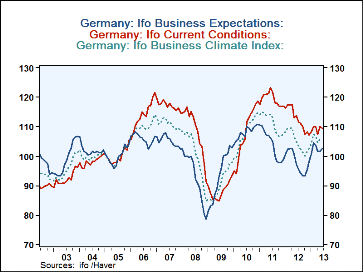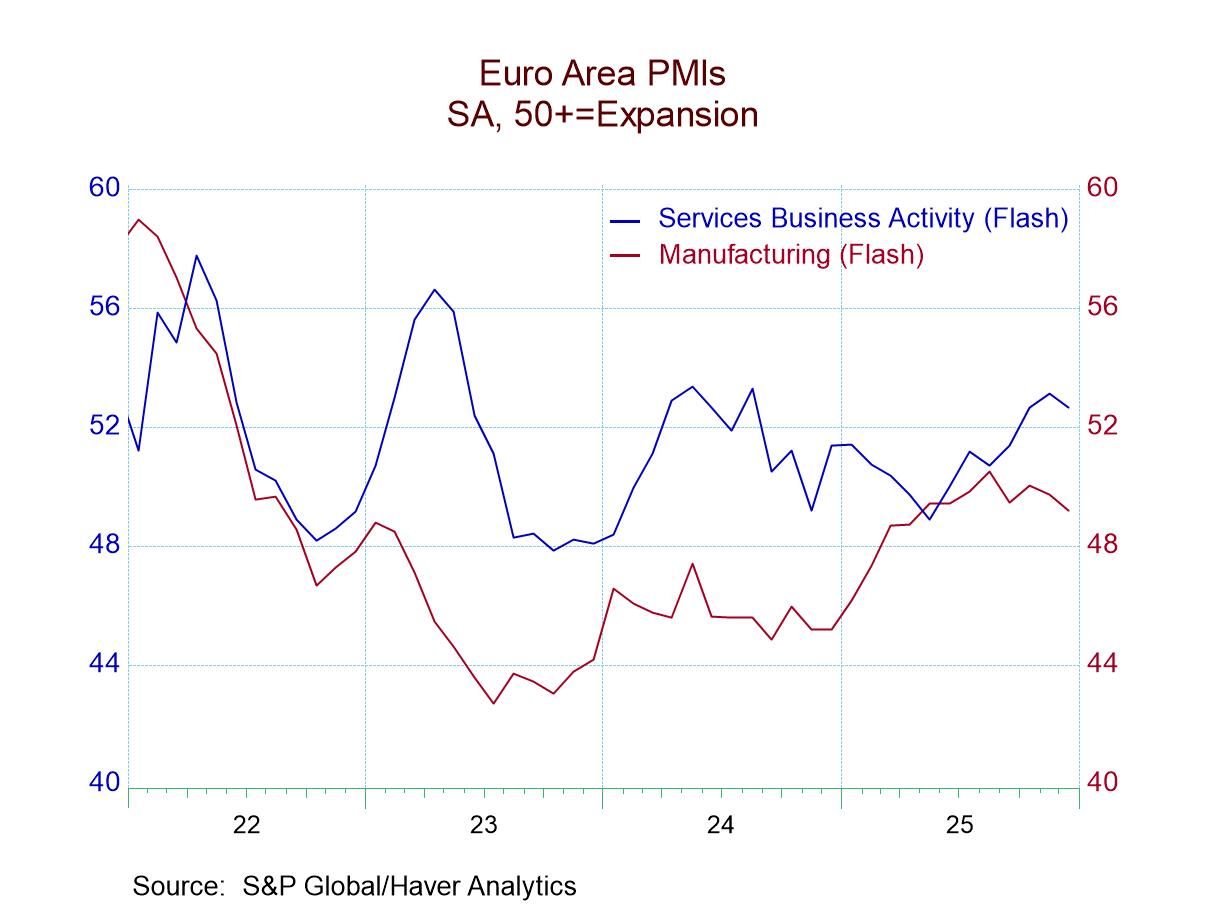 Global| Jun 24 2013
Global| Jun 24 2013IFO German Index Advances
Summary
The IFO headline index advanced this month on the strength of improved expectations as the current index toppled back month-to-month and increased its year-over-year drop compared to May. In the table we present the sector diffusion- [...]
 The IFO headline index advanced this month on the strength of improved expectations as the current index toppled back month-to-month and increased its year-over-year drop compared to May.
The IFO headline index advanced this month on the strength of improved expectations as the current index toppled back month-to-month and increased its year-over-year drop compared to May.
In the table we present the sector diffusion-version readings for business climate. The overall climate reading rose in June to net 4.4 from 4.1 in May. In diffusion terms the current index fell to 7.5 in June from a net of 8.6 in May as expectations rose to 1.4 from -0.4. The All-Sector reading for climate stands in the 75th percentile of its historic queue, higher only about 25% of the time - a reasonably firm perch. Current conditions are slightly better positioned in the 76the percentile of their queue with expectations lagging and standing in the 64th percentile of their historic queue.
Viewed by sector, only manufacturing improved this month, rising from a raw net reading of 6.1 in May to a net of 7.8 in June. Construction slipped to 1.0 from 1.2 as wholesaling and retailing each switched from net positive to net negative territory. Wholesaling posted a reading of -1 in June down from +1.7 in May as retailing slid to -1.4 from +0.1 in May. Despite the slippage construction still stands at the relative strongest ranking in its queue among sectors at the 97th percentile, followed by Retailing in the 80th percentile and wholesaling in the 80th percentile. Manufacturing stands in the 53rd percentile of its range barely above its historic median level (queue standing of 50).
The chart shows that Germany saw a rather rapid improvement in its business metrics early last year. Since April of last year, however, the improvement has lost some footing and has been moving sideways.
The current index is lower month to month and is lower than its Feb (2013) reading but is higher than most readings back to September of last year. Expectations are up this month but are below February and March levels. Still the index is equal to or higher than most readings back until July of 2011.
The German economy is well described by the path of the indices in the chart above. It recovered from the financial crisis, then its gains slowed and it began to show sporadic declines in some sectors and has since started to mend but it still struggling with that. All in all the German economy is still growing, but PMI metrics on German MFG show a legacy of declines. Germany continues to be the best-performing large country in EMU yet it is still faced with challenges. German elections have kept German policy largely unchanged since late last year.
The conservative Bundesbank approach to ECB policy got a boost today when the BIS (Bank for International Settlements) pronounced that extra monetary stimulus could not make up for weak growth and the errant fiscal policy. The BIS argued that excessively accommodative monetary policies had taken the heat off some countries that have not made the full scope of fiscal change that they should have implemented. With this the ears of our representatives in the US Congress should be stinging.
This debate has been alive and well (or not so well...) in the US for some time. The BIS noted that central banks could do whatever is necessary form their end to try to restore growth but that might not be enough (thereby turning on of Draghi's pledge of last year into an oxymoron- what if banks do all they can" but if that's not enough?).
After various cycles of boom, bust, and recovery in the last several years Germany is now experiencing a sort of a pause The German economy, like most of Europe, is still not in the place it would like to be. Currently the world growth environment is an issue with policy risk in China seeming to have reached some new heights and with an ostensible US move in the works to scale back on its QE making markets very nervous. That is making it a difficult environment for all central banks to make decisions. As market instability causes central banks to re-inspect their assumptions that economic conditions were stabilizing...Markets are not encouraged by the loss in guidance and presence of uncertainty where policy certainty once dominated the landscape.

Robert Brusca
AuthorMore in Author Profile »Robert A. Brusca is Chief Economist of Fact and Opinion Economics, a consulting firm he founded in Manhattan. He has been an economist on Wall Street for over 25 years. He has visited central banking and large institutional clients in over 30 countries in his career as an economist. Mr. Brusca was a Divisional Research Chief at the Federal Reserve Bank of NY (Chief of the International Financial markets Division), a Fed Watcher at Irving Trust and Chief Economist at Nikko Securities International. He is widely quoted and appears in various media. Mr. Brusca holds an MA and Ph.D. in economics from Michigan State University and a BA in Economics from the University of Michigan. His research pursues his strong interests in non aligned policy economics as well as international economics. FAO Economics’ research targets investors to assist them in making better investment decisions in stocks, bonds and in a variety of international assets. The company does not manage money and has no conflicts in giving economic advice.






